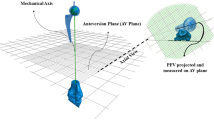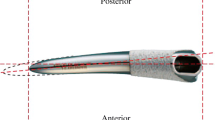Abstract
The anteversion of the stem is occasionally intentionally changed by the surgeon for patients with smaller femoral neck anteversion during total hip arthroplasty (THA). However, the reproducibility of preoperative planning with increasing anteversion has been rarely assessed. The present study investigated it using two types of stems. This retrospective study included patients who underwent primary posterolateral THA using taper-wedge (TS group; 73 hips) and anatomical (AS group; 70 hips) stems. Characteristics of sex and age were matched in the two groups by propensity score matching. In both groups, the relationship between the preoperative three-dimensional planning and postoperative stem position, and the relationship between postoperative stem position and femoral neck anteversion (FNA) were evaluated. In the TS group, there were no significant differences in average stem anteversion (SA) between preoperative planning and postoperative placement (36.1° ± 7.0° and 36.6° ± 11.1°, respectively: p = 0.651). The absolute error of SA was 8.1° ± 6.4°. In the AS group, the postoperative SA was significantly smaller than the preoperative planning SA (22.7° ± 11.6° and 30.0° ± 9.3°, respectively: p < 0.001). The absolute error of SA was 9.0° ± 5.8°. The postoperative SA was significantly larger than the FNA in the TS group (36.6° ± 11.1° and 26.3° ± 10.9°, respectively: p < 0.001). However, no significant differences between the two were observed in the AS group (23.7° ± 10.1° and 22.7° ± 11.6°, respectively: p = 0.253). The preoperative planning of intentional increasing anteversion did not show high reproducibility with taper-wedge and anatomical stems. The anatomical stem was placed according to the femoral medullary canal regardless of preoperative planning with increased SA.






Similar content being viewed by others
Data availability
We have the data used in this study stored in our facility and can disclose it upon request.
References
Shon WY, Baldini T, Peterson MG, Wright TM, Salvati EA. Impingement in total hip arthroplasty a study of retrieved acetabular components. J Arthroplasty. 2005;20:427–35.
Gerhardt DM, Sanders RJ, de Visser E, van Susante JL. Excessive polyethylene wear and acetabular bone defects from standard use of a hooded acetabular insert in total hip arthroplasty. Int Orthop. 2014;38:1585–90.
Nakahara E, Uemura K, Ando W, et al. Effect of a modular neck hip prosthesis on anteversion and hip rotation in total hip arthroplasty for developmental dysplasia of the hip. J Artif Organs. 2020;23:255–61.
Yamazaki K, Imagama T, Matsuki Y, et al. Evaluation of femoral anteversion, hip rotation, and lateral patellar tilt after total hip arthroplasty using a changeable neck system. J Artif Organs. 2021;24:492–7.
Iwana D, Nakamura N, Miki H, et al. Accuracy of angle and position of the cup using computed tomography-based navigation systems in total hip arthroplasty. Comput Aided Surg. 2013;18:187–94.
Hananouchi T, Takao M, Nishii T, et al. Comparison of navigation accuracy in THA between the mini-anterior and -posterior approaches. Int J Med Robot. 2009;5:20–5.
Dorr LD, Wan Z, Malik A, et al. A comparison of surgeon estimation and computed tomographic measurement of femoral component anteversion in cementless total hip arthroplasty. J Bone Jt Surg Am. 2009;91:2598–604.
Wines AP, McNicol D. Computed tomography measurement of the accuracy of component version in total hip arthroplasty. J Arthroplasty. 2006;21:696–701.
Hirata M, Nakashima Y, Ohishi M, et al. Surgeon error in performing intraoperative estimation of stem anteversion in cementless total hip arthroplasty. J Arthroplasty. 2013;28:1648–53.
Pongkunakorn A, Phetpangnga N, Kananai N. Accuracy of intraoperative estimation of femoral stem anteversion in cementless total hip arthroplasty by using a digital protractor and a spirit level. J Orthop Surg Res. 2021;16:27.
Kitada M, Nakamura N, Iwana D, et al. Evaluation of the accuracy of computed tomography-based navigation for femoral stem orientation and leg length discrepancy. J Arthroplasty. 2011;26:674–9.
Nishihara S, Sugano N, Nishii T, et al. Comparison between hand rasping and robotic milling for stem implantation in cementless total hip arthroplasty. J Arthroplasty. 2006;21:957–66.
Nakahara I, Kyo T, Kuroda Y, Miki H. Does difference in stem design affect accuracy of stem alignment in total hip arthroplasty with a CT-based navigation system? J Artif Organs. 2021;24:74–81.
Miki H, Yamanashi W, Nishii T, et al. Anatomic hip range of motion after implantation during total hip arthroplasty as measured by a navigation system. J Arthroplasty. 2007;22:946–52.
Sugano N, Noble PC, Kamaric E. Predicting the position of the femoral head center. J Arthroplasty. 1999;14:102–7.
Dorr LD, Faugere MC, Mackel AM, et al. Structural and cellular assessment of bone quality of proximal femur. Bone. 1993;14:231–42.
Sugano N, Noble PC, Kamaric E. A comparison of alternative methods of measuring femoral anteversion. J Comput Assist Tomogr. 1998;22:610–4.
Montgomery AA, Graham A, Evans PH, Fahey T. Inter-rater agreement in the scoring of abstracts submitted to a primary care research conference. BMC Health Serv Res. 2002;2:8.
Bland JM, Altman DG. Measuring agreement in method comparison studies. Stat Methods Med Res. 1999;8:135–60.
Widmer KH, Zurfluh B. Compliant positioning of total hip components for optimal range of motion. J Orthop Res. 2004;22:815–21.
Abe H, Sakai T, Takao M, et al. Difference in stem alignment between the direct anterior approach and the posterolateral approach in total hip arthroplasty. J Arthroplasty. 2015;30:1761–6.
Taniguchi N, Jinno T, Koga D, et al. Cementless hip stem anteversion in the dysplastic hip: a comparison of tapered wedge vs metaphyseal filling. J Arthroplasty. 2017;32:1547–52.
Noble PC, Kamaric E, Sugano N, et al. Three-dimensional shape of the dysplastic femur: implications for THR. Clin Orthop Relat Res. 2003;417:27–40.
Acknowledgements
This research was supported by Japan Agency for Medical Research and Development (AMED) under Grant Number JP22he0122010.
Author information
Authors and Affiliations
Corresponding author
Ethics declarations
Conflict of interest
The authors declare that they have no conflict of interest.
Additional information
Publisher's Note
Springer Nature remains neutral with regard to jurisdictional claims in published maps and institutional affiliations.
Rights and permissions
Springer Nature or its licensor (e.g. a society or other partner) holds exclusive rights to this article under a publishing agreement with the author(s) or other rightsholder(s); author self-archiving of the accepted manuscript version of this article is solely governed by the terms of such publishing agreement and applicable law.
About this article
Cite this article
Kaneoka, T., Imagama, T., Okazaki, T. et al. Evaluation of the reproducibility of preoperative three-dimensional computed tomography planning for posterolateral approach total hip arthroplasty. J Artif Organs (2023). https://doi.org/10.1007/s10047-023-01396-x
Received:
Accepted:
Published:
DOI: https://doi.org/10.1007/s10047-023-01396-x




